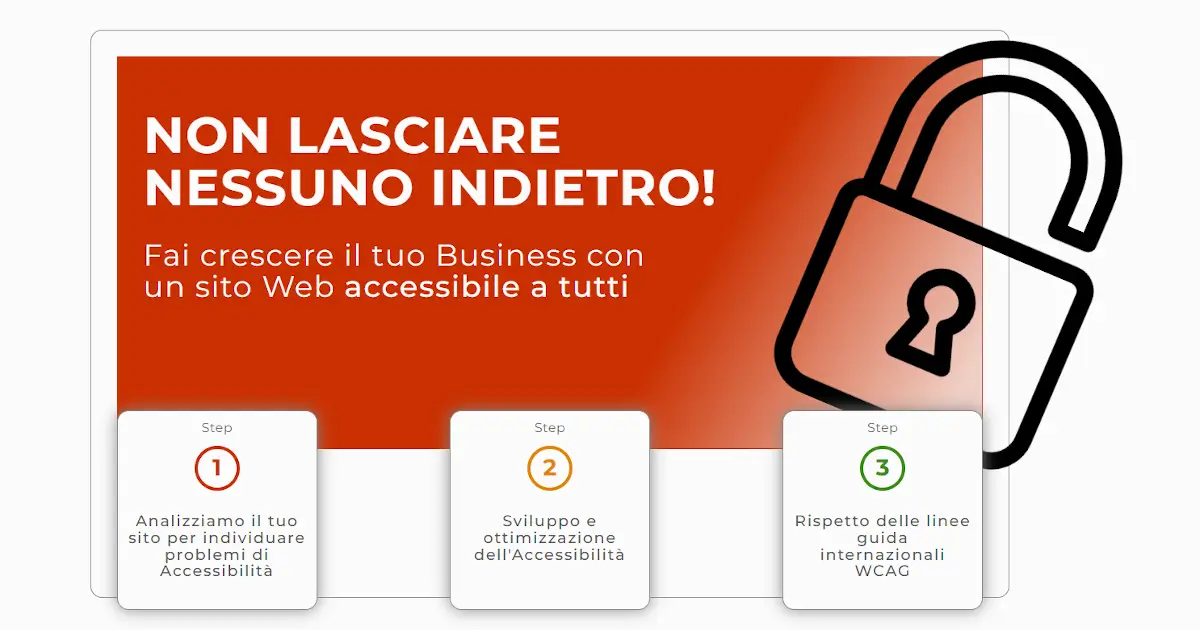
Non lasciare
nessuno indietro!
Fai crescere il tuo Business con
un sito Web accessibile a tutti
➽ Verifica l'accessibilità del tuo sito ora
Analizziamo il tuo sito per individuare problemi di Accessibilità
Sviluppo e ottimizzazione dell'Accessibilità
Rispetto delle linee guida internazionali WCAG
Analizziamo e valutiamo la tua Accessibilità
Valutare l'accessibilità di un sito Web è un passaggio fondamentale per assicurarsi che tutti gli utenti, indipendentemente dalle loro capacità, possano accedere ai contenuti. In quest'ottica il riferimento principale sono le linee guida Web Content Accessibility Guidelines (WCAG) che prevedono tre livelli di conformità: A (minimo); AA (intermedio) e AAA (massimo).
-
Soddisfiamo le Normative internazionali sulla Accessibilità
Le normative sull'accessibilità Web variano a seconda del paese, ma molte si basano su standard internazionali come le WCAG citate nel punto precedente. In Europa, la principale normativa in tema di Accessibilità è l'European Accessibility Act (direttiva UE 2019/882), che mira a migliorare l'Accessibilità dei prodotti e dei servizi digitali in tutta l'Unione Europea entro il 2025. Questa direttiva impone che vari servizi e prodotti, inclusi i siti Web, siano accessibili alle persone con disabilità, seguendo in genere le WCAG 2.1 Livello AA. In Italia, la Legge 4/2004, conosciuta come Legge Stanca, regola l'accessibilità dei siti web della pubblica amministrazione. Questa legge si applica a tutte le pubbliche amministrazioni, enti pubblici, aziende di servizi pubblici e aziende che offrono servizi online a clienti finali.
-
Scadenze, obblighi e sanzioni
L'European Accessibility Act, citato nel punto precedente, impone di rendere il proprio sito pienamente accessibile entro il 28 giugno del 2025. Da questa applicazione rimangono escluse le microimprese, aziende con un numero di dipendenti inferiore a 10 persone e che hanno un fatturato annuo non superiore a 2 milioni di euro. I soggetti interessati dovranno presentare ogni anno una Dichiarazione di Accessibilità nella quale dichiarare pubblicamente lo stato di accessibilitò del proprio sito Web o applicazione mobile.
-
I vantaggi pratici di un sito accessibile
Un sito Web accessibile offre numerosi vantaggi pratici, sia per l'azienda o organizzazione che lo gestisce, sia per gli utenti. Un sito accessibile consente di raggiungere persone con disabilità visive, uditive, motorie o cognitive, che altrimenti potrebbero incontrare difficoltà nell'interagire con un sito non ottimizzato. Si stima che circa il 15% della popolazione mondiale viva con una qualche forma di disabilità. In quest'ottica, rendere il sito accessibile amplia il potenziale bacino di utenti.
Molti dei principi dell'accessibilità, come l'uso corretto di testi alternativi per le immagini, l'ottimizzazione dei titoli e una struttura chiara delle pagine, aiutano anche i motori di ricerca a comprendere meglio i contenuti del sito. In più, un sito accessibile tende ad essere più facile da usare per tutti, non solo per le persone con disabilità.
Contattaci oggi per ottenere una analisi gratuita
Vicini a te
La tua attività è situata in provincia di Udine o in Friuli?
Hai un vantaggio in più: siamo vicini!

Che cos'è l'Accessibilità Web?
L'accessibilità Web si riferisce alla pratica di progettare e sviluppare siti Web in modo che siano utilizzabili da tutti, indipendentemente dalle loro capacità fisiche, cognitive o tecniche. L'obiettivo principale è garantire che le persone con disabilità possano accedere ai contenuti, navigare nei siti e interagire con le informazioni e le funzionalità senza incontrare alcun tipo di barriera all'accesso dei loro contenuti.
Quali siti devono essere accessibili?
In linea generale, tutti i siti web dovrebbero essere accessibili per garantire un’esperienza inclusiva a tutte le persone, comprese quelle con disabilità. Tuttavia, ci sono alcuni settori in cui l'accessibilità è particolarmente importante o comunque, obbligatoria. Ecco alcune categorie...
- Siti governativi: i siti delle pubbliche amministrazioni devono essere accessibili per Legge nella maggior parte dei paesi (in Europa vige la Direttiva 2016/2102, in USA la Section 508).
- Siti di servizi pubblici: siti relativi a trasporti, sanità, educazione e altri servizi essenziali devono garantire accesso a tutti.
- Siti di e-commerce: l'accessibilità è un fattore cruciale per permettere a tutte le persone, comprese quelle con disabilità, di effettuare acquisti online.
- Siti di intrattenimento: i siti che offrono contenuti multimediali (video, giochi, ecc.) devono garantire che tali contenuti siano fruibili anche da persone con disabilità sensoriali o motorie.
- Siti di educazione e formazione: le piattaforme e-learning e i siti di scuole e università devono essere accessibili per assicurare pari opportunità di apprendimento a tutti gli studenti.
- Siti di organizzazioni non profit: questi siti dovrebbero essere accessibili per promuovere l'inclusione e raggiungere tutti i membri della società.
Come ottimizzare l'Accessibilità di un sito Web?
Ottimizzare l'accessibilità di un sito web richiede una serie di azioni che migliorano l'esperienza di navigazione per tutti gli utenti, compresi quelli con disabilità.
Le linee guida suggeriscono principalmente che:
1. il testo e gli elementi grafici devono essere facilmente leggibili per tutti gli utenti, inclusi quelli con problemi di vista o daltonismo;
2. il sito deve essere completamente navigabile usando solo la tastiera, poiché alcune persone non possono utilizzare un mouse;
3. i moduli devono essere accessibili e chiari;
4. è necessario assicurarsi che l’interfaccia utente sia coerente in tutto il sito...
In generale, un design chiaro e prevedibile aiuta le persone con disabilità cognitive a navigare più facilmente.
Quali sono i 4 principi di Accessibilità?
L'accessibilità web si basa su quattro principi fondamentali stabiliti dalle WCAG (Web Content Accessibility Guidelines).
Per essere accessibile un sito deve essere percepibile: le informazioni e i componenti dell'interfaccia utente devono essere presentati in modo che gli utenti possano percepirli (contrasti, testi alternativi...).
Un sito deve essere utilizzabile: i componenti dell'interfaccia e la navigazione devono essere facilmente utilizzabili da tutti gli utenti (navigabilità tramite tastiera o dispositivi alternativi al mouse).
Il terzo principio si riferisce alla comprensione: le informazioni e l'operazione dell'interfaccia utente devono essere comprensibili (testi chiari, messaggi di errore non equivoci...).
Infine, l'ultimo principio è quello relativo alla robustezza: i contenuti devono essere sufficientemente robusti da poter essere interpretati da una vasta gamma di user agent, inclusi i dispositivi assistivi (HTML e CSS semanticamente valido e ben strutturato).




